Demographics change, and with them, B2B buyers’ demands change.
Since the mid-twenty-teens, Millennials have been a growing demographic in B2B buyer research and decision-making processes. Today, they not only have influence, these younger buyers are the decision-making majority.
In 2023, a Forrester survey revealed that buyers born after 1980—Millennials and Gen Zers—accounted for 71% of B2B buyers, while Generation X and Baby Boomers accounted for only 29%. If we factor in the nature of aging and that younger buyers made up 64% in 2022, this cohort of buyers is gaining positions of purchasing power by more than 10% YoY.
At that rate, they will make up more than 90% of B2B decision-makers by 2026.
Continue ReadingBaby Boomers
Want companies that help them grow their networks
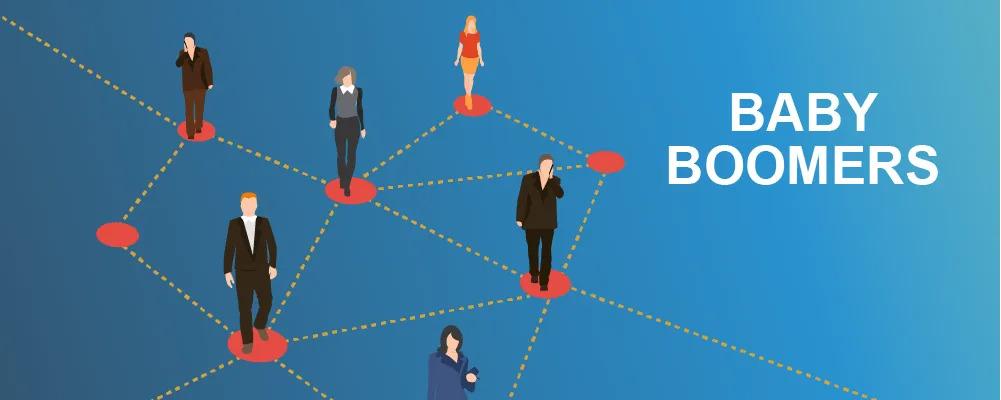
Baby Boomers are known for their work ethic, steadfast commitment to traditional values and a preference for direct, face-to-face interactions. They are the generation taught to work hard, prove themselves, do their time and show loyalty. Baby Boomer buyers, possibly influenced by their considerable professional background, tend to favour organisations with strong networks. They are twice as likely to cite prior experience with a provider as the main reason for initiating contact for information. Their tenure and extensive experience shape the way they tackle obstacles throughout the purchasing process.
Gen X
Look for learning opportunities in the B2B interactions
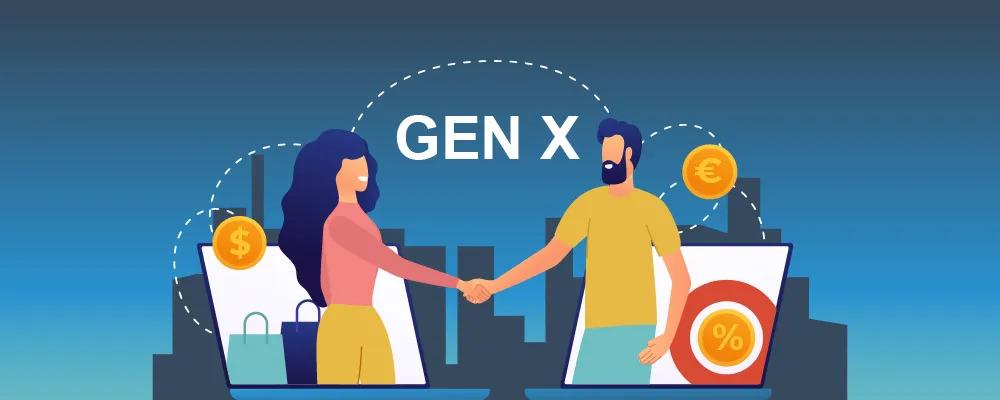
Generation X is value-driven. While Baby Boomers value experience and relationships, Generation X sought businesses that aligned with their values and preferences. Gen X buyers want efficient, credible B2B interactions with a personal touch. They are comfortable with technology but still value the in-person relationships they grew accustomed to in their early careers. That being said, they are more critical and will look at overall value rather than just price or personal relationships. What’s more, being digitally savvy but not digital natives, privacy is a big concern.
Millennials
Value companies that have a clear vision and make work enjoyable
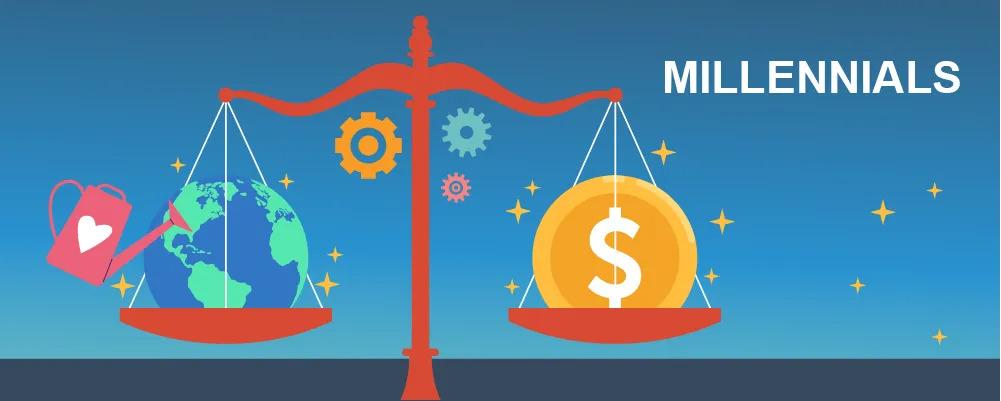
Millennials value transparency, social responsibility, and ethical practices. They prefer brands that align with their personal values and offer straightforward communication. They are the first generation to actively seek a meaningful work-life balance and appreciate companies that contribute positively to their work environment and personal well-being. As a result, Millennial buyers prioritize comprehensive, accessible information and a seamless digital experience in their B2B buying decisions. They conduct extensive research independently and favor companies that support a self-directed buying process with efficient, user-friendly digital tools. Additionally, they value personal benefits such as professional growth opportunities and enhancements to their work life.
Gen Z
Value quality, service, instant gratification and personalization
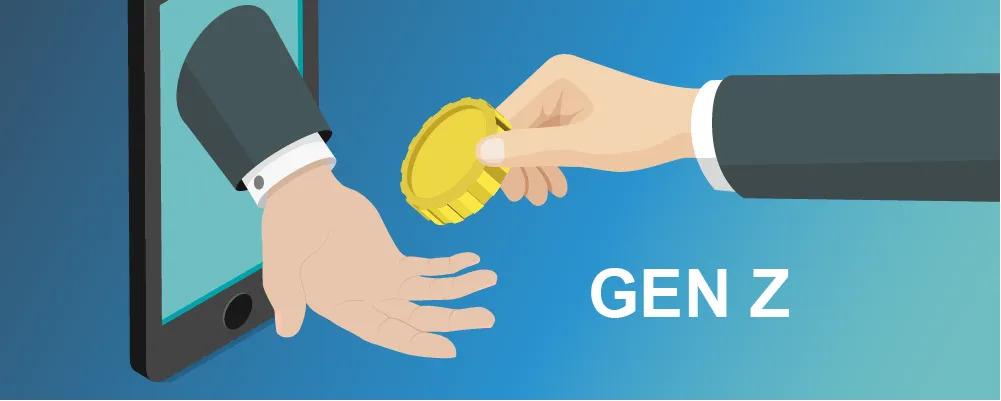
Gen Z stands out for their technological proficiency and strong social consciousness around diversity, inclusivity, and authenticity. This generation is highly skilled at discerning genuine content and narratives, and they value brands that foster an emotional connection, offering authentic and personalised experiences.
In their B2B buying decisions, Gen Z prioritizes quality, service, and rapid response times, reflecting their preference for instant gratification. They expect a high level of personalization in their interactions, showing a greater willingness to engage with brands that understand their unique needs and values. Additionally, Gen Z buyers are drawn to companies that leverage modern technology effectively and communicate their brand stories in an innovative and relatable way, often through digital and social media platforms. Balancing a marketing strategy that still caters to older generations, B2B marketing strategies are transitioning from prioritizing loyalty and face-to-face engagement to focusing on value-driven interactions and a blend of digital and personal connections and moving into a focus on authenticity, technological fluency, and personalized experiences.
This necessitates a marketing strategy that leverages advanced digital tools, prioritizes ethical practices, and delivers immediate, engaging content tailored to individual values and preferences. Simple.
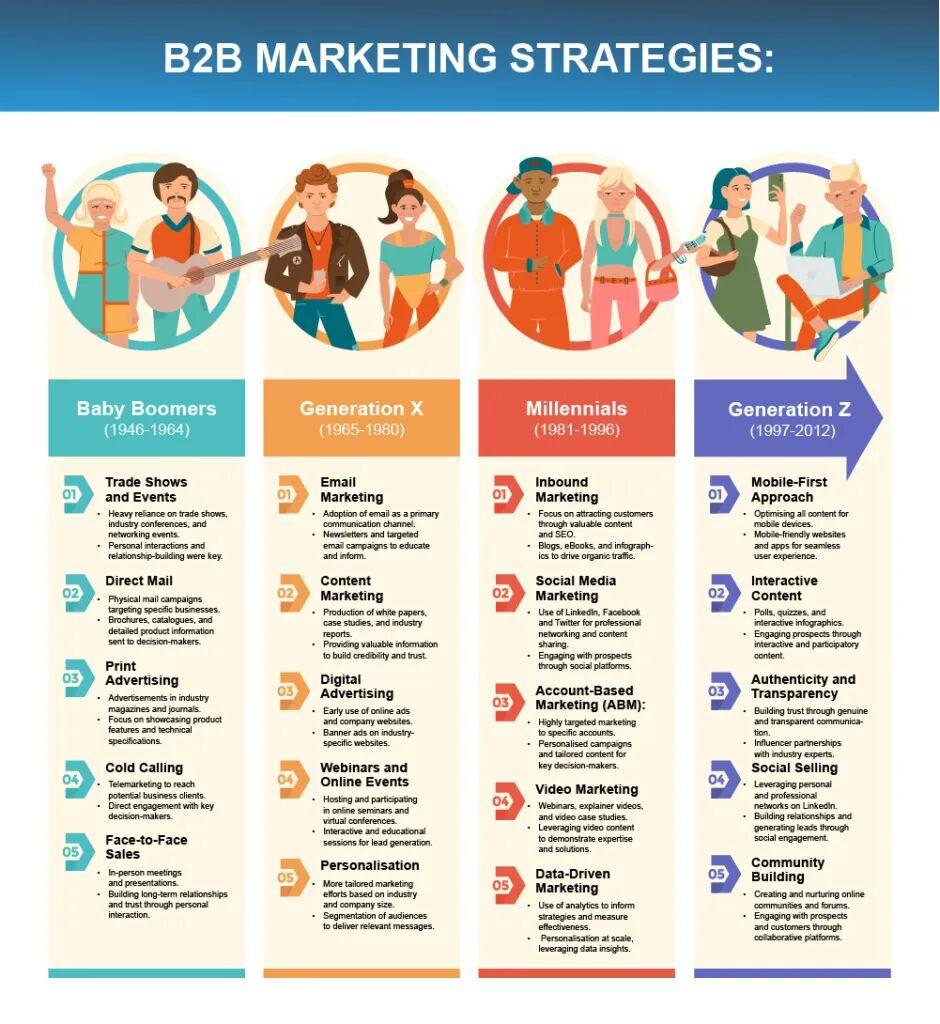
Where does that leave your current B2B marketing?
B2B notoriously moves slower than B2C. While B2C consumers have been all-in on brand engagement via smartphones, B2B buyers still today favour—by a small margin—desktop research.
Recent research found that 76% of traffic to the service pages came from desktops. But for blogs, that figure reduced to 59%. Desktop remains king because research in B2B is a hefty activity.
- Research phase
Younger B2B buyers spend significantly more time in the research phase of the buying journey than their older counterparts. But that doesn’t mean they like to waste time online. They seek self-driven discovery and have a preference for digital communication channels. They are more likely to use diverse information sources and want accessible, effortless support throughout this stage. - Communication preferences
Millennials and Gen Z want digital communication methods, including live chat and social media. These preferences highlight their expectation for faster access to information and solutions as they progress through the buying journey. - Brand loyalty and decision-making
Younger B2B buyers are less loyal. They are more likely to switch B2B suppliers, even with strong brand loyalty measured by metrics like Net Promoter Score (NPS). They value digital purchasing channels for their ability to offer personalized solutions but are critical of current B2B e-commerce experiences. Younger B2B buyers want digital-centric content, support, and solutions that empower them to make better decisions and research deeper and more critically than the generations before them.
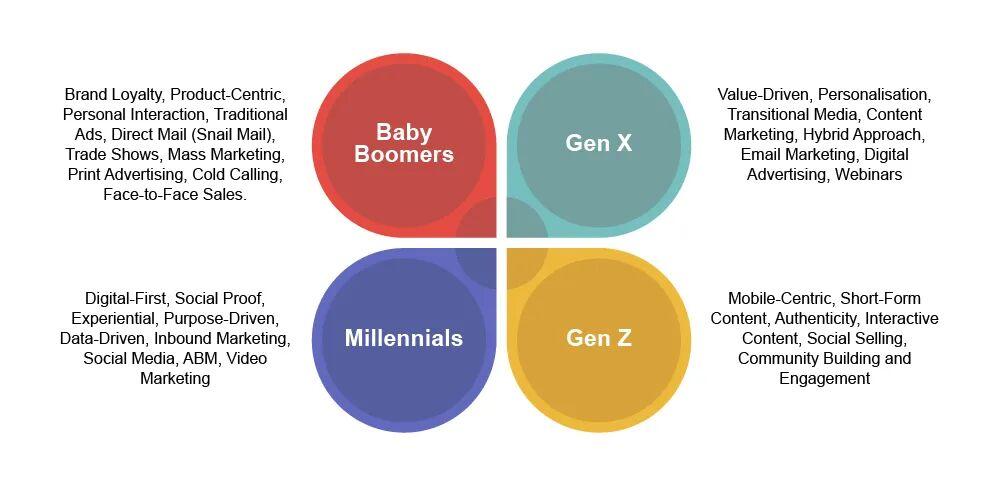
To market to younger B2B buyers, you have to solve these problems
In Gartner’s Insights on the B2B Buying Journey, they identified the biggest challenge B2B sellers have right now: digital domination impedes your business’s ability to sell.
- Limited seller interaction
Buyers now have extensive access to information through digital channels, which reduces the direct influence sellers traditionally had. The research found that B2B buyers spend a minimal portion of their purchasing time—only about 17%—interacting with potential suppliers. When considering multiple suppliers, this time drops even further to 5-6%. But your buyers want everything digital-first, so you have to find a digital way to win back your direct interactions. - Complexity in decision-making
The decision-making process in purchasing complex B2B solutions typically involves a group of 6 to 10 decision-makers, each equipped with multiple pieces of independently gathered information. This complexity is compounded by the growing number of available solutions and technologies, with over three-quarters of buyers describing their purchasing experience as complex or difficult. - Non-linear buying journey
The buying journey is characterized by a non-linear, looping pattern where buyers repeatedly revisit the six buying jobs rather than progressing sequentially. This looping makes it crucial for suppliers to provide information that helps buyers navigate these tasks more easily.
Digital solutions to digital problems
If the challenge is complexity in their internal processes and a lack of direct access from you to your buyer, digital solutions—while in some way part of the problem—can be part of the solution.
Invest in buyer enablement
Buyer enablement, or providing information that aids buyers in completing their buying jobs, significantly impacts the ease of purchase and the quality of deals. Buyers who receive helpful information are 2.8 times more likely to find the purchasing process easy and three times more likely to make larger purchases with less regret.
Modernize your sales strategies
The Gartner research suggests a need for a paradigm shift in sales strategies:
- Sales reps should be viewed as one of many information channels rather than the primary channel.
- Aligning strategies across digital and in-person channels is essential, as buyers use both concurrently.
- Sales and marketing efforts should operate in parallel to accommodate the non-linear, multi-channel buying process.
Sales and marketing need to be on the same team, accepting that they each play an important role in supporting the buying process.
Ideal channels and tactics to attract younger B2B buyers
The focus of now and the future should be:
1. Inbound marketing:
- Valuable, SEO-optimised content to attract and engage potential clients.
- Blogs, whitepapers, eBooks, and infographics to drive organic traffic and leads.
2. Account-based marketing (ABM)
- Targeted campaigns focused on high-value accounts.
- Personalization and tailored content for specific business needs.
3. Social media marketing
- LinkedIn for professional networking and content distribution.
- Engaging with prospects and clients through informative and interactive posts.
4. Video marketing
- Webinars, explainer videos, and video case studies.
- Utilizing video content to demonstrate expertise and provide solutions.
5. Data-driven marketing
- Using analytics to refine strategies and measure campaign effectiveness.
- Personalizing content and campaigns based on data insights.
6. Social selling
- Leveraging personal and professional networks on platforms like LinkedIn.
- Building relationships and generating leads through social engagement and content sharing.
7. Community building
- Developing and nurturing online communities and forums.
- Engaging with prospects and clients through collaborative platforms and discussion groups.
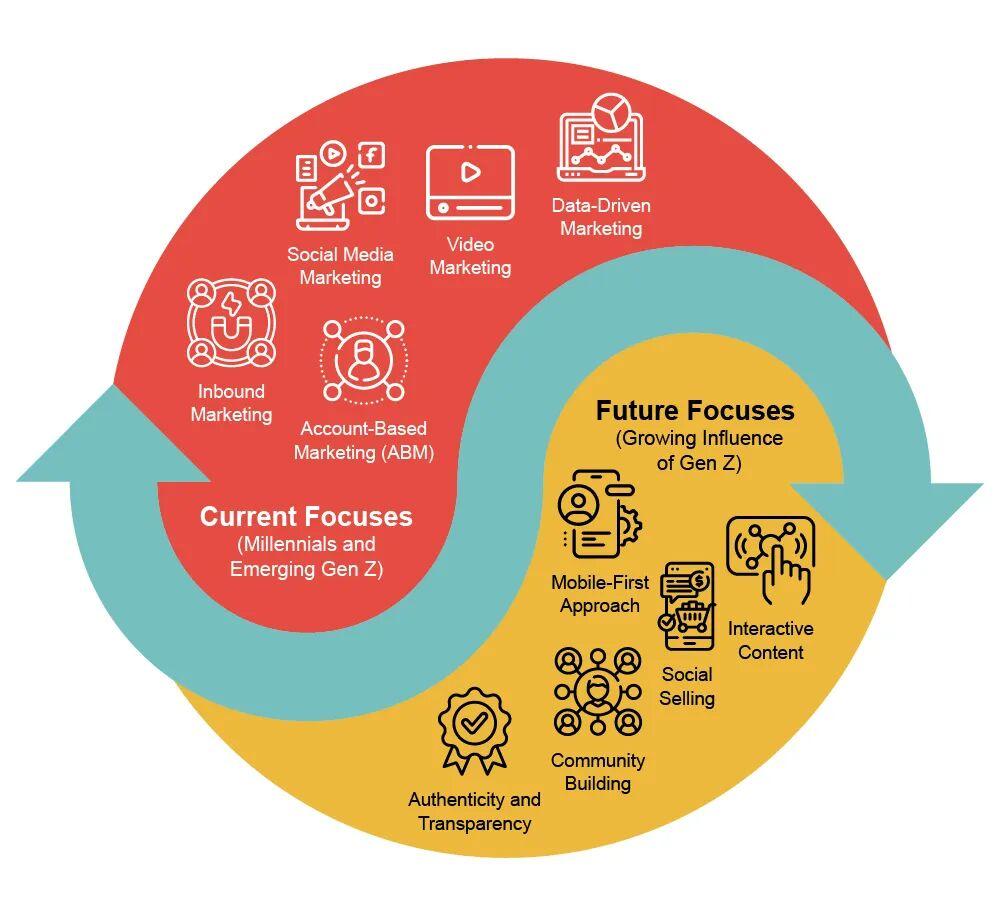
TL;DR (too long; didn’t read…)
- Millennials and Gen Z now dominate B2B buying decisions, comprising 71% of buyers in 2023, and are projected to make up over 90% by 2026.
- Younger B2B buyers value transparent, ethical practices and a seamless digital experience.
- Gen Z and Millennials prefer digital communication channels like live chat and social media and are less loyal to brands.
- Focus on digital solutions, buyer enablement, and modernizing sales strategies to effectively market to younger B2B buyers.
***
For More and Moving Ahead…
Talk to PHMC GPE Team !
Discover More:


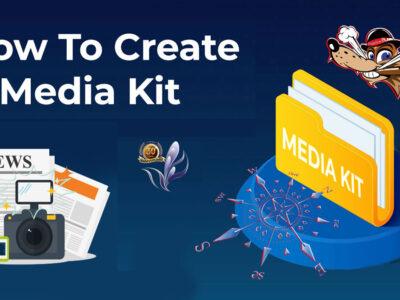
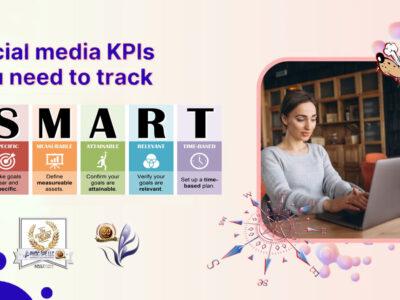
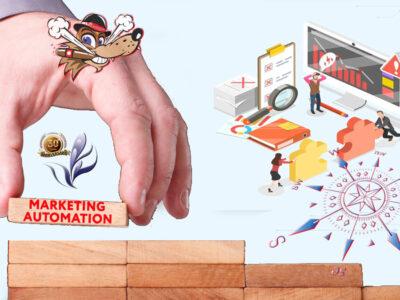
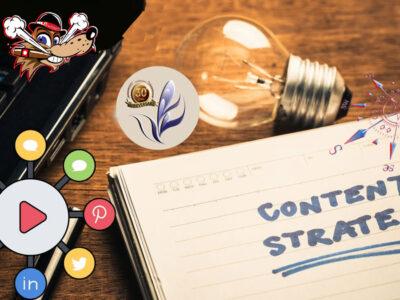










Comments